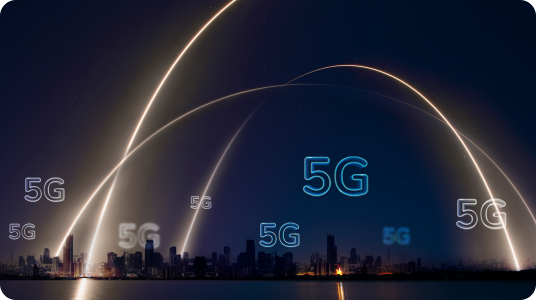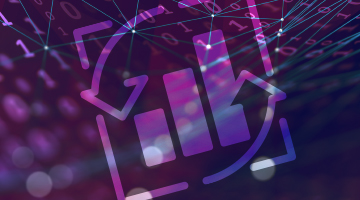Latency Reduction

The 5G Opportunity
As 5G infrastructure rollouts continue to accelerate, organizations are scrambling to capitalize on the ultra low latency promise of 5G technology and do things with data they could never do before.
Simply put, companies that are able to take a proactive stance to 5G networks stand to make the most of this digital transformation. According to a recent report from Grand View Research, the market for 5G is expected to haul in $46.6 billion in 2021 and climb to nearly $665 billion by 2028.
This makes perfect sense: In an age of ubiquitous connectivity, 5G, especially combined with other relatively new technologies such as cloud and edge computing, represents the next stage in the evolution of global connectivity. Not only does 5G promise to improve network utilization, decrease latency, accelerate decision-making, strengthen customer experiences, and ultimately deliver more value to end users, it also presents a number of opportunities to clever businesses looking to unlock new revenue streams.
For example, shrewd telco providers increasingly see 5G as an opportunity to supercharge their business support systems (BSS) by bolstering their billing processes and charging and policy functions to maximize monetization opportunities. Similarly, entertainment venues and gaming platforms are looking to 5G to enhance the stadium experience through lightning-fast augmented reality experiences.
Add it all up, and no matter your industry, it is critical to begin thinking about 5G monetization, how it might affect your operations, and what you can do to generate immediate ROI from your 5G investments. The sooner your organization begins to prioritize 5G monetization, the better positioned you’ll be to win in the future. It’s that simple.
What Is 5G Monetization?
5G monetization is the process of determining the policies, products, use cases, and business models that enable an organization to drive the most revenue from their 5G investments and 5G data. While telcos traditionally sold reliable connections and high speeds, 5G enables them to also monetize various network functions.
Rather than treating 5G infrastructure as a sunk cost, forward-thinking organizations are increasingly looking for ways to monetize their investments. To illustrate, telcos are thinking about things like network slicing and brokering their networks to offer better 5G services to consumers. Similarly, manufacturers are investing in 5G to usher in the era of Industry 4.0, with automated manufacturing and collaborative computing making production processes more efficient than ever before.
5G monetization is the process of earning revenue from 5g investments. This could include new business models and tactics that (communications service providers) CSPs must put in place. 5G infrastructure investments won’t be recouped through consumer business alone, so it’s important for CSPs (communications service providers) to explore all options to reduce cost. One potential scenario for 5G monetization is the development of new services that take advantage of 5G speeds and capacity.
Finally, 5G monetization could come from the sale of new devices that make use of 5G technology. 5G-compatible smartphones are already beginning to hit the market, and 5G-compatible laptops, tablets, and other devices are expected to follow in the coming years. The sale of these 5G-compatible devices could generate significant revenue for mobile device manufacturers. Let’s start unlocking new revenue streams and generating ROI from 5G investments.
5G network slicing can be monetized in a variety of ways, through partnerships with Mobile Virtual Network Operators (MVNOs), Mobile Network Operators (MNOs), infrastructure partners, Over The Top (OTT) providers, and vertical industries. This new technology offers great potential for businesses, business models, and service providers to create innovative bundles.
5G will enable new and immersive entertainment with Augmented Reality (AR) / Virtual Reality (VR) technologies and 8K video streaming by content providers. This will help mobile operators’ revenue growth.
Achieve 5G monetization with the Volt solution! This platform streamlines support of multiple network generations and offers full convergence across all offerings, customer segments, and payment models.
5G offers opportunities for new business models and premium services. By creating customized services, 5G enables new sources of revenue. 5G also supports high bandwidth applications which create new possibilities for immersive experiences Core Research Worldwide 5G Subscriber and IoT Connection Forecast, 2021-2025 Opportunity for 5G Fixed Wireless Access for Consumers and Businesses.
URLLC : (Ultra Reliable Low Latency Communications): It supports ultra-high reliability, ultra-low latency, strong security and extreme user mobility. mMTC / mIOT (massive Machine Type Communications or Massive Internet of Things)
It provides latency that is low enough to support Internet of Things (IoT) functions such as smart homes and buildings.
The Telco industry is going through a rapid change driven by technological advancements, spectrum access liberalization and changing user habits and demand. The move to 5G is an opportunity for telcos to reposition themselves as a critical part of the value chain rather than merely the providers of connectivity. With the adoption of machine learning, artificial intelligence, closed loop automation, and advanced analytics to handle next generation operations, the telecom sector is poised for a great digital transformation.
The Digital Tools and Strategies that Support 5G Monetization
To allow 5G monetization, CSPs require the proper tools and methods, especially since securely opening up their networks to partners for the first time. These are the most frequent items each CSP should have:An
- API strategy: CSPs need to confidently and securely work with partners to extend their 5G network. Through application programming interfaces (APIs), partners can connect to a CSP’s 5G network. Information is shared freely and securely through the API to deliver fast service.
- Business support service (BSS): BSS systems allow CSPs to combine APIs with external partners. They may also offer the logic required for partners to set up, price, and quote services all on one platform.
- Developer ecosystems: The value chain will be modified, expanded, and customized to meet the unique needs of each industry and category. To enable the network, developers will need to rely on trusted ecosystems that allow them to develop swiftly while also assisting the firm in developing new solutions for each use case.
How to Monetize 5G
When it boils down to it, there’s no shortage of ways to monetize 5G, regardless of the industry you operate in. That’s because the technology allows lightning-fast connectivity and real-time decisioning. With that in mind, let’s take a look at four of the more common ways organizations are monetizing their 5G investments.

1.Up-Level Policy And Charging
There’s no other way to say it: Traditional business and operational support systems (BSS and OSS) simply can’t keep up with the volume of data and the speed that’s needed to leverage it most effectively.
By moving away from legacy RDBMS and NoSQL database solutions and embracing modern BSS solutions that run on data platforms designed specifically for the 5G- and IoT-driven era, you’re able to efficiently and accurately charge millions of customers simultaneously, even though all of them are interacting with different streaming services.
Invest in a high-velocity decisioning engine designed to power real-time applications on 5G networks and never miss a 5G monetization opportunity again.
2.Eliminate Downtime
Imagine a customer managing a wind farm, with turbines distributed across several thousand acres of land in a remote location. With the right telco solutions in place, they can continuously and proactively monitor their infrastructure, making sure everything’s in optimal condition—which sure beats finding out after the fact when a turbine gets knocked offline.
One report puts the average cost of a single minute of downtime for a single server for a major network provider at $11,000 per minute. Even if you achieve four-nines availability, you’re still going to face 526 minutes of downtime each year—which adds up to nearly $5.8 million per year, again, just for a single server.
Use active-active-active cross data center replication (XDCR) and in-memory data storage to increase availability, achieve fine-nines availability, and nearly eliminate downtime altogether.


3.Improve Customer Value Management
In today’s day and age, customers increasingly expect personalized experiences. Believe it or not, 83 percent of consumers expect experiences to be personalized within hours—or even milliseconds.
Thanks to 5G networks and technologies designed to help organizations make the most out of them, it’s possible to take a proactive approach to customer value management and serve up personalized offers in rea -time based on predefined event triggers.
According to a recent study, telcos have a mere 250 milliseconds to make a targeted offer during a real-time customer engagement. Capitalizing on these opportunities is only possible when the contextual decisioning part occurs within 10 milliseconds of the beginning of the interaction—and this is only possible with a high-velocity decisioning engine.
Use the power of real-time decisioning intelligence to personalize every customer interaction, engage more customers, and sell more.
4.Prevent Fraud In Real Time
Telco fraud costs operators around the world upwards of $32 billion each year. As technology continues to evolve, fraudulent activities become increasingly complex, making them that much harder to catch without the right tools in place.
To prevent fraud in the 5G era, telcos can no longer afford to wait for information to travel to a data warehouse for analysis, because the fraudsters will already have won by then. Instead, analysis needs to happen rapidly, within 10 milliseconds, which requires real-time decisioning intelligence.
Good news: Thanks to 5G connectivity and machine learning, it’s possible for telcos to analyze millions of individual events each second, automatically identify suspicious behavior, and block fraudulent calls before a connection occurs. Since behavioral algorithms can continuously learn what bad actors look like, this enables telcos to become increasingly more adept at preventing fraud over time.
Use real-time data to proactively prevent fraud and fend off cyber attackers before they have a chance to do any damage.

Challenges with Monetizing 5G
While 5G delivers unlimited potential, monetizing 5G is one of the biggest challenges telco operators and other enterprises face today. Here are three reasons organizations are struggling with 5G monetization.
Acid Compliance In A Non-Acid-Complaint World
While NoSQL databases power many of the applications we use every day—like Netflix, Facebook, and LinkedIn—they simply can’t meet the data consistency and latency requirements to maximize 5G monetization and provide a true return on investment.
In order to make the most out of the 5G moment, enterprises need ACID-compliant data platforms that enable them to make complex decisions, quickly and consistently, every time, even with widely distributed users.

Customer Transience
In an age where all the information in the world is at our fingertips, customers have more options than ever before. One recent report found that 96% of customers will leave after a single bad experience. This means that the enterprises that serve these customers certainly have their work cut out for them.
This it’s why it’s so important to invest in purpose-built data platforms and network infrastructure. By doing so, you ensure exemplary experiences in each interaction—making your services sticky and your customers loyal.
Data, Speed, And Decisioning
While many telco providers are accelerating their digital transformation journeys, some are hesitant to adapt. Unfortunately for these late-comers, old-school tech stacks are simply incapable of keeping pace with the speed needed to accommodate an ever-increasing volume of data.
This is why it’s so important for organizations to look for versatile, proven data platforms that are capable of processing massive volumes of data rapidly, enabling real-time decisioning use cases.
Key Technologies For Monetizing 5G
All enterprises need to be able to do certain things to monetize 5G safely and affordably. These are the most important technologies that enable enterprises to take full advantage of 5G without breaking the bank.
NewSQL Data Platforms
If you’re trying to maximize 5G monetization, you won’t get there with tools literally designed for the pre-internet world, like traditional RDBMS solutions. And you also won’t get there with the NoSQL alternatives, which might be great for streaming content on your television or serving up relevant content on your favorite social network but fail the ACID compliance test and are therefore incapable of supporting 5G initiatives.If you’re looking to make the most out of 5G, you need applications that leverage NewSQL data platforms that deliver the availability, consistency, and performance needed to support complex, real-time use cases at scale.

Automation, AI, And Machine Learning (ML)
Success in the 5G-powered world requires making decisions at lightning speed. This simply isn’t possible with manual intervention, and tools built for a pre-internet world won’t cut it, either.
With powerful AI- and ML-powered applications analyzing data streams in real time, it’s possible to automate decisioning, enabling you to fully take advantage of every 5G monetization opportunity that comes your way.
IOT And Edge Computing
As organizations increasingly invest in IoT devices and infrastructures, the need for a corresponding edge computing infrastructure becomes more obvious.
In order for such investments to deliver desired returns, organizations need to make sure they have the infrastructure needed to process, analyze, and execute on data within 10 milliseconds of an event—which is precisely where 5G edge technology enters the equation.
In other words, telcos can’t afford to wait for data to travel anywhere. If it’s not acted upon immediately, it’ll lose all of its value by the time it gets to your data lake or data warehouse — which is why workloads need to be captured, stored, and analyzed at the network edge, or whichever location is closest to the point of data ingestion. Gartner estimates that 75% of data will be generated and processed at the edge by 2025, up from 10% as recently as 2018. To take full advantage of all of this data now being computed at the edge, you need to act as quickly on it as possible.

It’s Time to Accelerate Your 5G Monetization Efforts
5G monetization requires so much more than just data ingestion and movement:
- It requires bringing database and stream processing together, at the edge, to address the entire event data management cycle from ingestion to storage to decision.
- It requires applying sophisticated rules, algorithms, and machine learning models to massive streams of event data, applying that analysis to detect exceptions, and then making a decision.
- And finally, it requires doing all of the above in real-time (ie, within 10 milliseconds), consistently and accurately.


